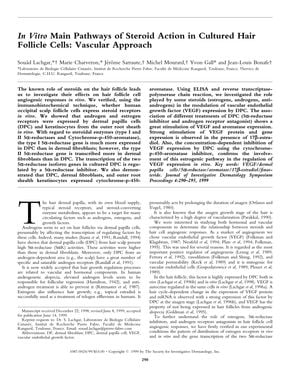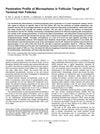In Vitro Main Pathways of Steroid Action in Cultured Hair Follicle Cells: Vascular Approach
December 1999
in “Journal of Investigative Dermatology Symposium Proceedings”

TLDR Steroids, particularly estrogens and 5α-reductase inhibitors, affect blood vessel-related hair growth processes in hair follicle cells.
The document from December 1, 1999, explored how steroids affect angiogenic responses in hair follicle cells, specifically focusing on steroid receptors, steroidal enzymes, and the impact on vascular endothelial growth factor (VEGF) expression by dermal papilla cells (DPC). The study revealed that DPC and keratinocytes from the outer root sheath expressed both androgen and estrogen receptors. It was found that the type I 5α-reductase gene had higher expression in DPC than in dermal fibroblasts, whereas the type II 5α-reductase gene was more active in dermal fibroblasts than in DPC, with its transcription in DPC being regulated by a 5α-reductase inhibitor. Additionally, DPC, dermal fibroblasts, and outer root sheath keratinocytes all expressed the enzyme cytochrome-p-450-aromatase. The study showed that treating DPC with a 5α-reductase inhibitor and an androgen receptor antagonist increased VEGF and aromatase expression. A significant increase in VEGF protein and gene expression was seen with 17ß-estradiol treatment, and the suppression of VEGF expression by a cytochrome-p-450-aromatase inhibitor confirmed the role of the estrogenic pathway in VEGF expression regulation in vitro. The conclusion was that hair growth regulation is linked to vascular and hormonal factors, with steroids, especially estrogens, and 5α-reductase inhibitors influencing hair follicle cell angiogenic responses.
View this study on jidsponline.org →
Cited in this study

research Penetration Profile of Microspheres in Follicular Targeting of Terminal Hair Follicles
Microspheres about 1.5 micrometers in size can best penetrate hair follicles, potentially reaching important stem cells.